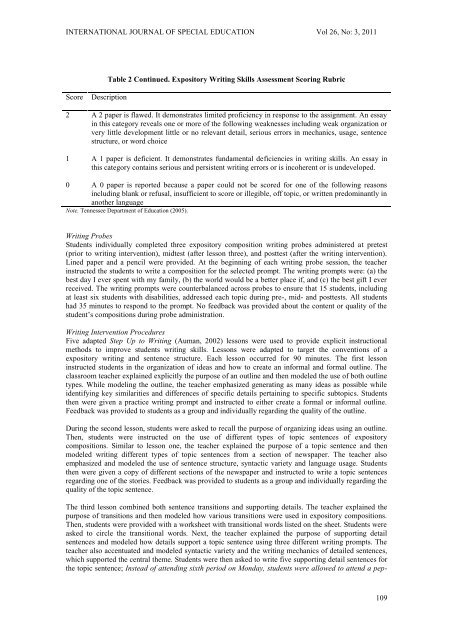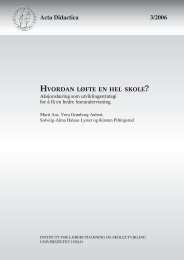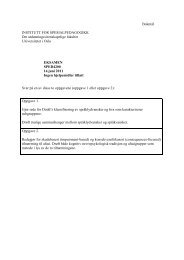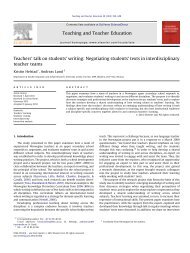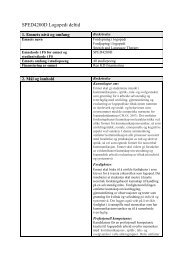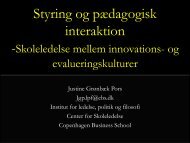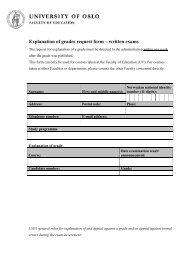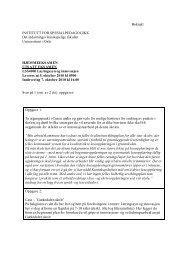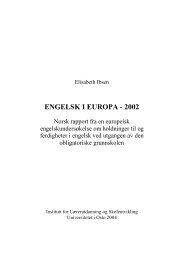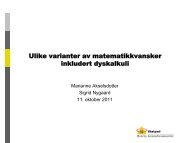International Journal Special Education
International Journal Special Education
International Journal Special Education
Create successful ePaper yourself
Turn your PDF publications into a flip-book with our unique Google optimized e-Paper software.
INTERNATIONAL JOURNAL OF SPECIAL EDUCATION Vol 26, No: 3, 2011Table 2 Continued. Expository Writing Skills Assessment Scoring RubricScoreDescription2 A 2 paper is flawed. It demonstrates limited proficiency in response to the assignment. An essayin this category reveals one or more of the following weaknesses including weak organization orvery little development little or no relevant detail, serious errors in mechanics, usage, sentencestructure, or word choice1 A 1 paper is deficient. It demonstrates fundamental deficiencies in writing skills. An essay inthis category contains serious and persistent writing errors or is incoherent or is undeveloped.0 A 0 paper is reported because a paper could not be scored for one of the following reasonsincluding blank or refusal, insufficient to score or illegible, off topic, or written predominantly inanother languageNote. Tennessee Department of <strong>Education</strong> (2005).Writing ProbesStudents individually completed three expository composition writing probes administered at pretest(prior to writing intervention), midtest (after lesson three), and posttest (after the writing intervention).Lined paper and a pencil were provided. At the beginning of each writing probe session, the teacherinstructed the students to write a composition for the selected prompt. The writing prompts were: (a) thebest day I ever spent with my family, (b) the world would be a better place if, and (c) the best gift I everreceived. The writing prompts were counterbalanced across probes to ensure that 15 students, includingat least six students with disabilities, addressed each topic during pre-, mid- and posttests. All studentshad 35 minutes to respond to the prompt. No feedback was provided about the content or quality of thestudent’s compositions during probe administration.Writing Intervention ProceduresFive adapted Step Up to Writing (Auman, 2002) lessons were used to provide explicit instructionalmethods to improve students writing skills. Lessons were adapted to target the conventions of aexpository writing and sentence structure. Each lesson occurred for 90 minutes. The first lessoninstructed students in the organization of ideas and how to create an informal and formal outline. Theclassroom teacher explained explicitly the purpose of an outline and then modeled the use of both outlinetypes. While modeling the outline, the teacher emphasized generating as many ideas as possible whileidentifying key similarities and differences of specific details pertaining to specific subtopics. Studentsthen were given a practice writing prompt and instructed to either create a formal or informal outline.Feedback was provided to students as a group and individually regarding the quality of the outline.During the second lesson, students were asked to recall the purpose of organizing ideas using an outline.Then, students were instructed on the use of different types of topic sentences of expositorycompositions. Similar to lesson one, the teacher explained the purpose of a topic sentence and thenmodeled writing different types of topic sentences from a section of newspaper. The teacher alsoemphasized and modeled the use of sentence structure, syntactic variety and language usage. Studentsthen were given a copy of different sections of the newspaper and instructed to write a topic sentencesregarding one of the stories. Feedback was provided to students as a group and individually regarding thequality of the topic sentence.The third lesson combined both sentence transitions and supporting details. The teacher explained thepurpose of transitions and then modeled how various transitions were used in expository compositions.Then, students were provided with a worksheet with transitional words listed on the sheet. Students wereasked to circle the transitional words. Next, the teacher explained the purpose of supporting detailsentences and modeled how details support a topic sentence using three different writing prompts. Theteacher also accentuated and modeled syntactic variety and the writing mechanics of detailed sentences,which supported the central theme. Students were then asked to write five supporting detail sentences forthe topic sentence; Instead of attending sixth period on Monday, students were allowed to attend a pep-109


